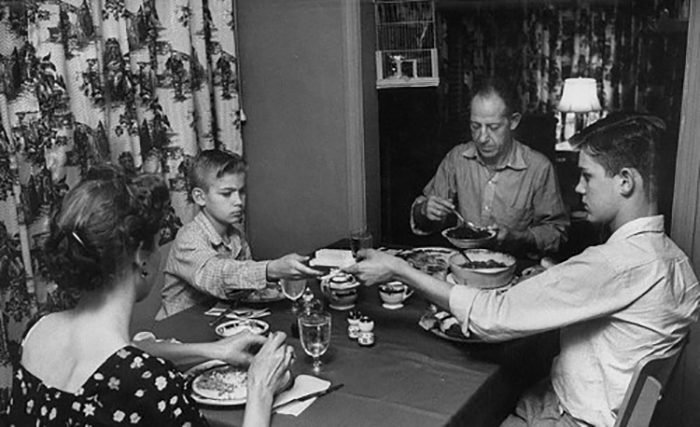
Does your family life seem chaotic?
Are you worried that your children aren’t learning and incorporating the values that are important to you and your wife?
Do you feel like your family is just a bunch of strangers who happen to live in the same house and share the same last name?
Well today we’re going to share a secret that successful and happy families use to increase solidarity, reduce stress, and inculcate values.
It’s regular family meetings.
I know. I know. I can hear the collective groans emanating across cyberspace.
Just as with family mission statements, most folks balk at the idea of having regular family meetings because they seem so forced, structured, and well — let’s be honest here — super freaking cheesy.
I get it. My church encourages everyone to have a weekly family night that includes a fun activity and a short lesson or devotional on some virtue or scripture, and growing up I thought the idea was pretty goofy.
But now that I’m a dad, I’m starting to whistle a different tune. I want to create a positive family culture within my own family. I want my kids to feel like they’re part of a team that has their back no matter what. I also want to instill in them values and skills that will serve them well and help them develop into contributing members of society.
But that sort of stuff doesn’t just happen. If you want to foster a successful family, you have to father with intentionality.
While a family mission statement can provide the big-picture vision for your family, regular family meetings are how you take that vision and turn it into action. It’s where the rubber meets the road.
All families, regardless of your beliefs and background, can benefit from making regular meetings one of your family traditions. Below we share the benefits of family meetings, as well as offer tips on how to get started with creating and carrying out your own.
The Benefits of a Family Meeting
There has actually been a surprising amount of research on the benefits of regular family meetings. Below we highlight some of them:
Solves problems. Instead of having a family that walks on eggshells around an obvious problem that never gets resolved because no one wants to talk about it, weekly meetings can be used to eliminate the tension and hash out the issue. Besides working through problems that the family is facing as a group, family nights are also a great way to help individual members with whatever issues they might be dealing with.
Reduces stress. By providing an opportunity to sync calendars and get everyone in your family on the same page about what’s going on in the household, weekly meetings can greatly reduce the stress that often plagues modern families.
Builds family solidarity. A family that meets together stays together. Dedicating time each week to teach, plan, and have fun as a family will build a firm foundation of solidarity that’s able to withstand life’s storms.
Boosts fathers’ confidence and purpose. In his book, The Seven Habits of Highly Effective Families, Stephen Covey referenced a study of the benefits of family meetings. The thing that surprised its author the most was how big a boon family meetings were to fathers in particular. Not only did fathers in the study report feeling closer to their families, they also felt a renewed sense of confidence and self-regard. It makes sense. Many men want to be a leader in their homes, but aren’t sure how, and family meetings allow men to exercise this leadership in a concrete and tangible way.
Reinforces family culture and values. Remember: a good family culture doesn’t just happen. You have to constantly work at it. Family meetings are an effective way to reinforce your family’s culture and values. They offer a regular opportunity to explicitly teach the principles you want to instill in your children as well as discuss how to apply them in real-life situations.
Teaches children vital life skills. Just by taking part in regular family meetings, your kids will pick up important life skills like problem solving, planning, conflict resolution, and communication. If you let your kids take turns leading a lesson or discussion during your family night, they’ll also learn valuable teaching and public speaking skills. Besides helping them develop these soft skills, you can also dedicate family nights to teaching specific life skills like how to budget, how to take care of a car, how to be civically engaged, and of course, how to throw a tomahawk.
How to Plan and Execute a Family Meeting
You can be as formal or informal as you want with your family nights. Every family is different, so use your discretion to decide what will work best. Here are some general tips and guidelines to help get you thinking about how you’d like to plan and execute your family meetings.
Take the lead. I realize it’s not considered kosher to say things like “head of the household” anymore, but in my experience, many, many women would still love for their husbands to take a leadership role in the home. Wives and mothers take charge of so many other details at home and at work, that they’re grateful for you to take the reins on some things. Make planning and executing regular family meetings one of those things.
Shoot for once a week. Aim to have a family meeting once a week. Pick a time that doesn’t conflict with anyone’s schedule. For some families that might be Sunday night; for others it might be Saturday afternoon. We do ours on Tuesday night, and I’m sure it will change as the kids get older and our commitments change.
Make it a priority. Even though you should take your schedule and kid’s activities into consideration when choosing a regular time to hold your family meetings, once you have done so, make following through and having your kids attend as non-negotiable as possible. Schedule other activities around it whenever you can and don’t toss it out the window just because you’ve had a long day or are tired. Commit to consistency.
Establish a general agenda. Having a rough outline of what you’ll do at each meeting will make planning easier. And knowing what to expect makes the meeting more bearable for your family. Below we provide a template. There are no set rules here – you can follow this to a T, adapt certain elements, or do something completely different.
- Open the meeting. Create a ritual you always use to open the meeting. Start with a prayer or a song, or read your family’s mission statement aloud.
- Teaching time. Each week dedicate 5-15 minutes to teaching or discussing a topic important to your family. Below we provide a section dedicated to what you might talk about during this time. No need to be heavy-handed with the teaching — keep it engaging for everyone. Also, don’t worry if it appears your rugrats aren’t paying attention. You’d be surprised how much kids pick up while they’re picking their noses.
Ideas for Teaching Time
Many parents hope their kids will simply pick up on the values and virtues that are important to them. And truly, teaching by example is the most effective way to pass on your principles. But it’s also good to talk explicitly about them to you children – so you can have a real discussion. Don’t assume you’re on the same page and they see things the same way you do. Allow your kids to ask questions about your beliefs and air doubts. As you share your viewpoint, listen to their perspective on it.
If you’re religious, you’ll likely want to discuss tenets of your faith during the teaching time segment of your weekly family meetings. Talk about the meaning of a scripture or a lesson to be found in a Bible story. If you can come up with a hands-on activity that ties in with the lesson, all the better.
Teaching time isn’t just for religious families though, and can be a great tradition for secular families too. And even if you are religious, you can expand the topics discussed beyond faith; I know I plan to devote our family meetings not simply to gospel topics but to talking about good character in general and civic virtue as well.
What are some good secular resources and ideas for instilling character and competence in your kids? Here are a few suggestions:
- Share and discuss a poem.
- Read a book together as a family and devote family meetings to a book club-type discussion.
- Ask each member of the family to share one thing they learned that week.
- Talk about current events.
- Talk about how the government works and how your children can be good citizens.
- Discuss critical thinking skills and how your kids can evaluate the information they come across.
- Discuss the role of technology in your lives, its pros and cons, and what would be good limits to place on it.
- Teach your kids a basic life skill like how to create a budget or change a tire.
- Discuss different principles of etiquette and how to act in a dignified manner in various situations.
- Talk about the importance of nutrition and exercise.
- Play classical music and have each person discuss which selections they like.
- Have each family member share three things they’re grateful for.
- Discuss different ethical quandaries and ask your kids how they would handle them.
- Read and discuss a selection from Marcus Aurelius’ Meditations
- Pick one of Benjamin Franklin’s 13 virtues each week, discuss its meaning and how to implement it into day-to-day life, make it a goal to work on it that week, and then discuss how you did with that goal at the following meeting.
- Pick a story from William Bennett’s Book of Virtues (or The Children’s Book of Virtues) and discuss what it teaches about character.
- If you have sons, share and discuss an excerpt from Manvotionals. Some of the selections in the book apply to young women as well.
Anything that edifies should be on the table for teaching time. The possibilities are limited only by what values you want to impart to your kids.
- Sync calendars. After the lesson, take some time to sync calendars. Each member of the family lets each other know what they have on their agenda for the coming week. You might consider creating a shared Google Calendar for just family stuff so everyone is on the same page. Besides syncing calendars, sync to-do lists. Assign chores and tasks for upcoming family projects.
- Family review and retrospective. In The Secrets of Happy Families, author Bruce Felier took a lesson from tech startups and tried implementing “agile development” into his family’s weekly meetings. Agile development is a system that many software development companies use to get constant feedback on how projects are going in order to make adjustments on the fly. An important principle of agile development is the weekly “review and retrospective” in which teams get together to discuss issues and make action plans based on changing circumstances. Felier incorporated this idea into his family meetings by spending time discussing these three questions:
- What worked well in our family this week?
- What went wrong in our family this week?
- What will we work on this coming week?
By regularly discussing these questions, everyone should have a good idea of what’s working well and not so well in your family, as well as have a constantly updated plan of action for what to do if things go awry. The key thing to remember with the family review and retrospective questions is to focus on how you’re doing as a family. Don’t use this time to discuss individual problems or grievances. You’ll have time for that later.
- Ask if anybody needs help with anything. After discussing problems that you’re family is facing as a group, dedicate some time for individual family members to bring up personal problems they could use some help on.
- Have fun! Every family meeting/night should end with something fun. What constitutes fun will vary from family to family. Play video or board games together. Take a walk. Shoot slingshots. Make pizzas. Whatever floats your family’s boat. Including, quite literally, root beer floats.
- Close the meeting. Have a closing ritual too. Sing a song, do another prayer, have a family hug or cheer, or do a combo of such things. Always try to end on a positive note.
- Eat a treat. Knowing a delicious cookie or bowl of ice cream awaits at the end of the meeting gives everyone something to look forward to, and for kids can be used as an incentive for having good behavior during the meeting.
Be flexible too. While having a regular agenda is helpful, there will be times when you’ll need to dedicate more time to a specific category. You don’t have to plan or solve problems at every meeting; sometimes you should just dedicate the entire family time to having fun. On the other hand, there will be times when you’ll need to dedicate the whole meeting to resolving problems and forego the fun. Be flexible and adapt as circumstances necessitate. The treat part is non-negotiable though.
Get everyone involved. Don’t make family meetings a one-man show. Try to get everyone involved as much as possible. When discussing issues, make sure everyone gets a say. Get your kids’ input on activities you should do or topics you should discuss.
As your kids get into their elementary school years, assign them responsibilities during the family meeting. For example, you could assign one person to be the secretary and write down “minutes” during the family review. You can also assign kids to teach a lesson, make the refreshments, or plan the fun activity. Remember, one of the goals of family meetings is to instill important life skills in your kids. Don’t deny them these opportunities by being a family meeting tyrant.
Vary the length depending on how old kids are. It’s tempting to decide you won’t have family meetings until the kids leave the toddler phase, but I think it’s good to start instilling the tradition, even if in a compressed form, while they’re young. Right now our family meetings are really short — only about 10 minutes — because that’s about all a 3-year-old’s attention span and level of cognition can take. But Gus already knows that Tuesday night is family meeting night.
As your kids get older, you can increase the length of the meeting but try not to go longer than an hour at the most. If you and your wife need more time to plan and sync calendars, you can do that with just each other at a later time.
Don’t have high expectations. The big issue I’ve seen with people incorporating family meetings into their own families is that they have unreasonably high expectations going into it. Parents have this image in their minds of their kids sitting quietly on the floor paying rapt attention to dear old dad smoking a pipe while dispensing sage advice on life next to a fire. Afterwards the family laughs and laughs as they eat banana splits.
Of course that’s not how it goes.
Kids moan and groan about coming to the meeting. Instead of discussing family issues calmly, pandemonium ensues. When you’re trying to teach some important principle, your toddler is sticking Legos up his nose.
Because the meeting doesn’t line-up with their idealized version, many parents just give up on the project because what’s the use.
Don’t fall into that trap. Even if your family meetings are less than idyllic, there’s still value in holding them. First, you’d be surprised how much your kids are picking up on even while they pummel each other on the carpet. Second, even if your kids moan and groan about them now, when they’re adults they’ll probably appreciate and even look back fondly at your family’s weekly meetings.
Don’t let the perfect be the enemy of the good. Go into your family meetings with reasonable expectations. Expect a little chaos from time to time and just do what you can. Just because you don’t see a benefit immediately, doesn’t mean you haven’t sewn some amazing seeds that will bear the fruit of family love and personal character down the road.
Listen to my podcast with Bruce Feiler for even more tips:
Read the other posts in the series:
The Importance of Creating a Family Culture
How and Why to Create a Family Mission Statement
The Importance of Establishing Family Traditions
60+ Family Tradition Ideas
How to Get the Most Out of Family Dinners
How to Become Your Family’s Transitional Character







